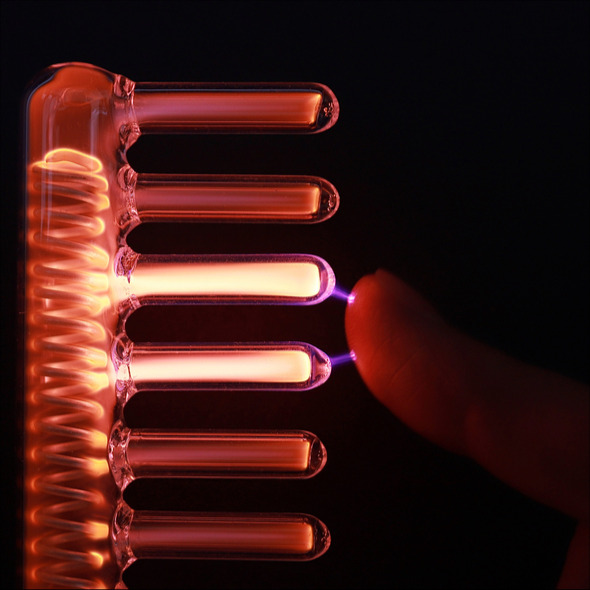
Plasma generators vs. zappers:
A comparison of frequency transmission in therapy
In the world of alternative healing methods, there are a
variety of approaches based on different principles and techniques
. Two devices that have received increasing attention in recent years
are plasma generators and zappers.
These devices are used in frequency therapy,
an area that deals with the application of electrical frequencies for the
treatment of various complaints.
In this blog post, we want to take an in-depth look at the differences between plasma generators and zappers, particularly in relation to frequency transmission to the body.
What is frequency therapy?
Before we dive into the specific differences between
plasma generators and zappers, let's take a look at the
basic concept of frequency therapy.
Frequency therapy is based on the idea that every
cell, tissue and organ in the human body vibrates at a
specific frequency.
If these frequencies are disturbed by external factors such as stress,
toxins or pathogens, this can lead to health
problems.
Frequency therapy aims to restore these natural frequencies and promote health by introducing healing frequencies into the body through various devices.
The zapper: basics and mode of action
The zapper is a device that was popularised by Dr Hulda Clark, a biophysicist and naturopath, in the 1990s . The device generates electrical impulses at specific frequencies that are designed to kill parasites, bacteria, viruses and other pathogenic organisms in the body. These frequencies are conducted into the body via electrodes placed on the skin .
Most zappers work at a relatively low frequency, often in the range of a few kilohertz. The idea is that these frequencies selectively attack harmful organisms without harming human cells. Zappers come in a variety of designs, from simple handheld devices to more complex systems that offer multiple frequencies or programmes.
Plasma generators: a modern approach
Plasma generators are a more recent development in frequency therapy and are based on the principle of the Rife machine, which was developed by Royal Raymond Rife in the 1930s. These devices generate frequencies using a plasma light that comes from a gas discharge tube . The generated light waves or electromagnetic waves carry the frequencies that are intended to penetrate the body.
A special feature of plasma generators is their ability to generate very high frequencies that can reach into the megahertz range. These high frequencies can penetrate deeper into the tissue and affect a wider range of pathogenic microorganisms. Plasma generators allow precise tuning to specific frequencies needed for the treatment of certain diseases or conditions.
Differences in the transmission of frequencies to the body
A major difference between plasma generators and zappers lies in the way the frequencies are transmitted to the body . As already mentioned, zappers use direct electrical contact with the skin to transmit their frequencies. This can lead to limitations in terms of penetration depth and even distribution of the frequencies in the body.
Zapper devices in use
Electricity has certain physical limitations:
Electricity always takes the shortest path and the lowest resistance.
Specifically, for the user this means that when using hand electrodes, the direct current flows from the hand via the chest to the other hand and the secondary currents (depending on the device and power) to the head or navel.
When using foot electrodes, we also have the main currents from foot to foot and the secondary currents. Alternatively, some device manufacturers offer the option of a four-point support, where hand and foot electrodes can be used together.
Air acts as an insulator
There are therefore also limitations with air
Plasma generators in use
Plasma generators, on the other hand, use the medium of light or an electromagnetic field to transmit the frequencies. Light waves can diffuse more evenly through the tissue and thus reach deeper areas that may be inaccessible to electrical impulses. Furthermore, it is assumed that the light field of a plasma generator can create a kind of resonance in the body that supports healing at the cellular level.
Areas of application and effectiveness
The areas of application of plasma generators and zappers overlap to a certain extent, as both aim to combat unwanted microorganisms in the body and promote health. However, there are a few things to consider when choosing the right device.
Zappers are often used by people looking for a simple and cost-effective solution. They are particularly popular with users who focus on treating parasite infestations.
Plasma generators, on the other hand, are often used for more complex conditions or difficult-to-treat diseases where it is important to apply very specific frequencies with precision.
Safety and side effects
The safety of frequency therapy devices is an important aspect to consider. Both zappers and plasma generators should be used under the guidance and possibly under supervision of an experienced therapist. The direct application of electrical impulses by a zapper can cause skin irritation or discomfort in some people . Plasma generators, on the other hand, are generally very gentle and are often perceived as more pleasant, as they do not send direct electrical signals through the skin.
In conclusion, plasma generators and zappers both have their place in the world of frequency therapy, but work in different ways and offer different benefits. If you are interested in either of these devices, it is recommended that you research further, read testimonials and, if necessary, consult professionals in this field to make the best decision for your individual needs and health goals.
